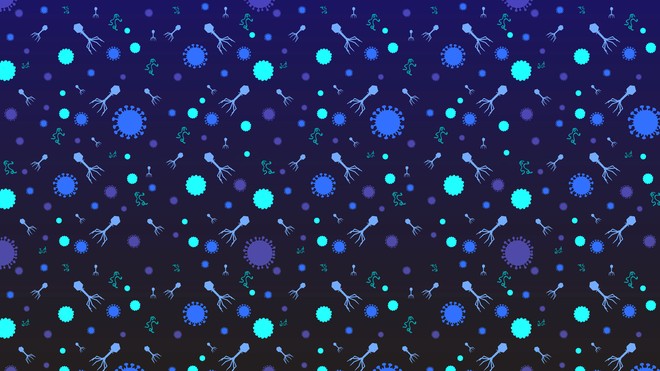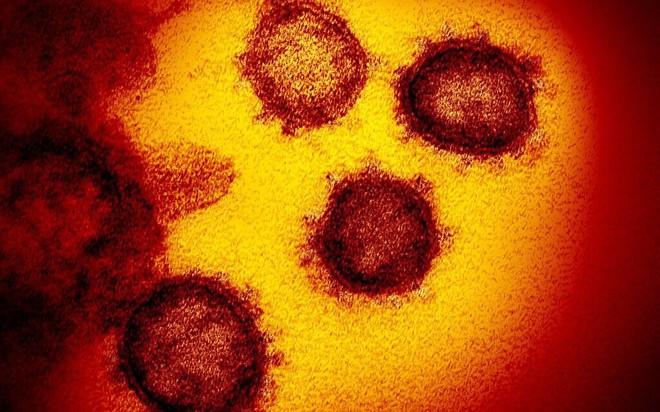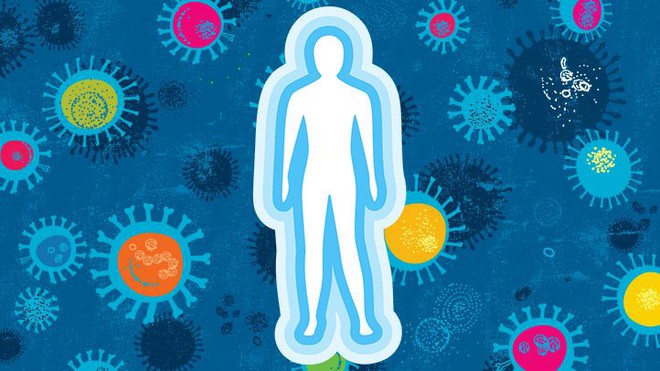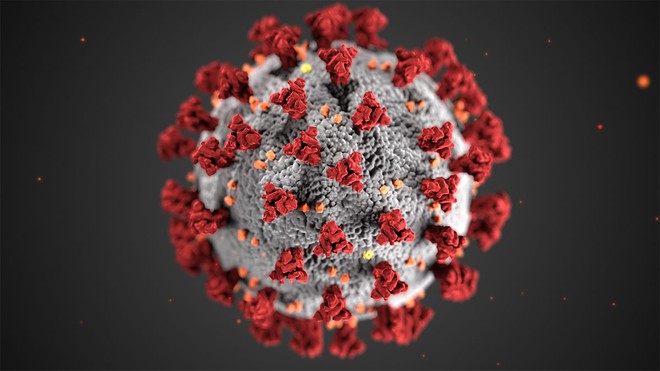The reason why the virus that causes Covid-19 is so difficult to destroy: the man between “chemistry and biology”, “living and not living”
- Tram Ho
Viruses have undergone billions of years of evolution to perfect their survival skills without having to work hard, which is the ingenious survival tactic that turns them into a threat to modern society.
No need to turn to the history page to find information, you can see that’s true in the current situation: the new strain of the corona virus, called SARS-CoV-2, has slowed down the normal pace of life. What little genetic material is covered by a protein shell of prickly spikes, the size of a body that is only 1/1000 of a human hair, can live pretending to have enough elements to be called a “living creature”. “and so dangerous?

Once they enter our airways, the virus injects genetic material into the epithelial cells that surround the lungs, creating millions of copies of it. The virus continues to spread inside the cell until the infected cell signals to self-destruct. When the cell breaks down, the virus continues to spread.
How this pathogen works makes us concerned: They can invade the body silently. Even before subjects became infected, they began to replicate themselves and through coughing spells, passing them on to the next victims. It can both knock down a person quickly and cause mild symptoms on others, allowing them to spread easily before the patient can be isolated.
There is no way to prevent SARS-CoV-2, but right now, researchers are making every effort to develop drugs and vaccines that have spread to more than 35,000 people worldwide, causing 15,000 people. dead. Below is a scientific record of the evil virus.
The virus lies between “chemistry and biology”.
The virus causes respiratory infection and replicates itself in two places: either in the nose and throat, where the infection rate is very high, or in the lower lung, where they do not spread strongly but can decay. breaking cells very quickly.

But this new strain of corona virus is different. They reproduce in the upper part of the airway, where they can easily fly to other victims through coughing and sneezing. But in some people infected, SARS-CoV-2 deep in the lungs of the victim and can be fatal. The new strain is both flu-like and cold-killing, just like its SARS cousin that was raging in 2002-2003.
SARS-CoV-2 still carries with it another disturbing characteristic: although the likelihood of death is similar to that of SARS, SARS-CoV-2 causes less pronounced symptoms, that is, the patient may transmit for others when they don’t know they’re carrying the virus.
With this hidden ability, SARS-CoV-2 is a virus capable of causing global disaster.
Viruses like these have caused many disease outbreaks over the past century: three major pandemics of 1919, 1957 and 1968; SARS, MERS and Ebola pandemic. Like the corona virus that causes influenza, the aforementioned diseases are spread from animals, and all the viruses that carry the gene are RNA.
Scientists think this is no coincidence. The fact that these RNA viruses survive as zombies and just wait for infection makes them both easy to spread and difficult to destroy. Living without a host, the virus will not work. These are special creatures that exist rather than live: they do not carry the digestive ability to create energy, cannot move, cannot reproduce.

Viruses can live like that for years. New studies have shown that although SARS-CoV-2 often degrades after a few minutes or hours in the host, some transmissible material can still live on paperboard surfaces for 24 hours, on plastic surfaces. and stainless steel for up to 3 days. In 2014, scientists successfully revived the virus trapped in permafrost for 30,000 years, still able to infect an amoeba when alive.
When the virus comes into contact with a host, they use proteins that are present on the body’s surface to attack cells that are unaware that they will be infected. The virus takes control of the cell, forcing the cell to produce the material needed for virus replication.
” They switch back and forth between living and non-living states , “ says microbiology professor Gary Whittaker. He described the virus as being ” in the middle of chemistry and biology “.
Among other types of RNA-carrying viruses, corona viruses have different sizes and capacities. Compared to the pathogens that cause dengue, West Nile and Zika fever, they are three times bigger, bringing three “tools” to help them spread them more effectively.
Virology expert Vineet Menachery used the comparison, saying dengue carried only one infectious tool (the mosquito), but the corona virus carried up to three things, applicable in three situations. different situations. One of these is the “acceptability” protein, which allows corona virus to correct biological errors during cloning; In addition, the ability to change allows them to adapt to new environments, whether living in animals or in the human nasal cavity.
Scientists believe that the SARS virus is derived from the virus on bats, spread by humans through civets. Tracing the origin of the virus that is causing the Covid-19 epidemic today, we have also found bats, with an intermediary species most likely being a pangolin sold at Wuhan Seafood Market.
” I think that for the last 20 years, nature has been trying to tell us, ‘Hey, the corona virus from a bat can cause a pandemic in humans, and we need to treat them as pandemic flu, as a threat. sticking on forever ‘ ‘, microbiologist Jeffery Taubenberger said. When SARS was released, a large amount of virus research funding was seen but now it has run out again, because corona virus causes only influenza, not listed as a priority pathogen.
Find weapons against the “enemy” Covid-19 and SARS-CoV-2 soldiers
Once inside the host cell, a virus can make up to 10,000 copies of it in just a few hours. After a few days, the infected person will have hundreds of millions of particles of material capable of transmitting the disease in just a few milliliters of blood. Virus also activates the strongest weapon that humans have before the disease, which is our own immune system. Ominous thing: our weapon is a double-edged sword.
The chemicals that suppress the released virus, the body temperature is pushed up to kill the pathogen, the white blood cells work hard to wipe out the enemy. But when the immune cells reach the lungs, the virus infects them, sending these reinforcements into a state of insanity, continuing to send signals to the body to send more “reinforcements”. again.
Among the immune cells, there are two notable names: neutrophil has the ability to release enzymes that destroy cells and T cells capable of destroying other cells, by sending signals to the cell itself. safely cancel. But when SARS-CoV-2 drove these two brave soldiers crazy, they began to destroy healthy cells. So we have to find medicine.

Most antibiotics engage in antimicrobial resistance by interfering with the destructive mechanism between the pathogen and the cells they target. For example, penicillin blocks the bacterial molecules used to make cell walls for them. This amazing drug is effective against thousands of bacteria, and because human cells do not use proteins that are affected by penicillin, we can safely take medicine.
But the virus works through the host, which is us. Because they have no organs, they cling to human cells to survive. Their protein is our protein, the virus’s weakness is the weakness of human cells. Naturally, the anti-virus will kill us.
Therefore, antiviral drugs must be absolutely accurate. A drug must be able to target the proteins produced by the virus in order to work, but this also means that a drug is usually effective only for one virus.
Viruses evolved extremely quickly, making early treatments obsolete. That’s why scientists are constantly coming up with new ways to cure the HIV virus, and the reason patients have to take a dozen or so medications to survive, and that’s why they are evolving more and more to resistance. new.
” Modern drugs have to keep up with the emerging viruses ,” said virus expert Karla Kirkegaard.
The knowledge we have about SARS-CoV-2 virus is limited. Although their behavior is different from that of SARS brothers, the mechanism of using protein spikes for infection does not show much difference. Understanding these proteins, we can find an effective vaccine. Research shows that the protein spikes on SARS cause the human immune system to respond in such an extreme manner, and new scientific reports suggest that SARS-CoV-2 uses the same approach.

This breakthrough brings hope to researchers: the vaccine may target the protein spikes of the SARS-CoV-2 virus! If our body receives a version of these proteins, our immune system can learn to recognize the virus and respond more moderately. And if SARS-CoV-2 is like SARS, it proves that it won’t evolve quickly, giving science more time to find an antidote.
What you can do for science is simple: don’t think about being afraid of infection, but behaving so you don’t spread the germs to anyone (even though you can make sure you don’t get sick). . Isolation at home, restricting to public places, declaring the ability to contact with suspected people, physical training and sports at home to enhance the health and immune system of each individual are effective methods.
In the long run, one more thing that will help us overcome Covid-19 is the virus itself. No matter how effectively they infect, defeating us, the ultimate goal of every living thing is … to survive.
Based on the evolutionary perspective, the scientists said that the ultimate goal of the virus is to spread the virus and cause mild symptoms on the host, sticking to the “parasite” rather than Try to destroy us as quickly as possible.
Effective killing viruses like SARS and Ebola are often so effective … no one has survived illness to spread the infection. But microorganisms that exist in a way that reduces the quality of human life exist in parallel with humans. A 2014 study found that the strain of the virus that causes oral herpes spreads through body fluids has lived in the same human line for 6 million years. Virologist Kirkegaard called herpes the ” resounding ” virus.
Looking at Covid-19 from this perspective, we see that SARS-CoV-2 is only at an early stage of life. They are still replicating themselves in a bluff, unknown life long enough. Over time, its RNA will change. Perhaps in the not too distant future, Covid-19 is just a disease that makes us sneeze every time the wind comes to the sky.
According to the Washington Post, WHO, CDC
Source : Genk
